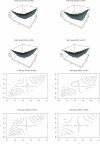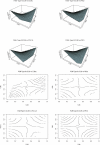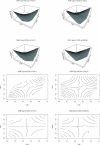A copula method for modeling directional dependence of genes
- PMID: 18447957
- PMCID: PMC2386493
- DOI: 10.1186/1471-2105-9-225
A copula method for modeling directional dependence of genes
Abstract
Background: Genes interact with each other as basic building blocks of life, forming a complicated network. The relationship between groups of genes with different functions can be represented as gene networks. With the deposition of huge microarray data sets in public domains, study on gene networking is now possible. In recent years, there has been an increasing interest in the reconstruction of gene networks from gene expression data. Recent work includes linear models, Boolean network models, and Bayesian networks. Among them, Bayesian networks seem to be the most effective in constructing gene networks. A major problem with the Bayesian network approach is the excessive computational time. This problem is due to the interactive feature of the method that requires large search space. Since fitting a model by using the copulas does not require iterations, elicitation of the priors, and complicated calculations of posterior distributions, the need for reference to extensive search spaces can be eliminated leading to manageable computational affords. Bayesian network approach produces a discretely expression of conditional probabilities. Discreteness of the characteristics is not required in the copula approach which involves use of uniform representation of the continuous random variables. Our method is able to overcome the limitation of Bayesian network method for gene-gene interaction, i.e. information loss due to binary transformation.
Results: We analyzed the gene interactions for two gene data sets (one group is eight histone genes and the other group is 19 genes which include DNA polymerases, DNA helicase, type B cyclin genes, DNA primases, radiation sensitive genes, repaire related genes, replication protein A encoding gene, DNA replication initiation factor, securin gene, nucleosome assembly factor, and a subunit of the cohesin complex) by adopting a measure of directional dependence based on a copula function. We have compared our results with those from other methods in the literature. Although microarray results show a transcriptional co-regulation pattern and do not imply that the gene products are physically interactive, this tight genetic connection may suggest that each gene product has either direct or indirect connections between the other gene products. Indeed, recent comprehensive analysis of a protein interaction map revealed that those histone genes are physically connected with each other, supporting the results obtained by our method.
Conclusion: The results illustrate that our method can be an alternative to Bayesian networks in modeling gene interactions. One advantage of our approach is that dependence between genes is not assumed to be linear. Another advantage is that our approach can detect directional dependence. We expect that our study may help to design artificial drug candidates, which can block or activate biologically meaningful pathways. Moreover, our copula approach can be extended to investigate the effects of local environments on protein-protein interactions. The copula mutual information approach will help to propose the new variant of ARACNE (Algorithm for the Reconstruction of Accurate Cellular Networks): an algorithm for the reconstruction of gene regulatory networks.
Figures






Similar articles
-
TimeDelay-ARACNE: Reverse engineering of gene networks from time-course data by an information theoretic approach.BMC Bioinformatics. 2010 Mar 25;11:154. doi: 10.1186/1471-2105-11-154. BMC Bioinformatics. 2010. PMID: 20338053 Free PMC article.
-
MICRAT: a novel algorithm for inferring gene regulatory networks using time series gene expression data.BMC Syst Biol. 2018 Dec 14;12(Suppl 7):115. doi: 10.1186/s12918-018-0635-1. BMC Syst Biol. 2018. PMID: 30547796 Free PMC article.
-
Using Bayesian networks to analyze expression data.J Comput Biol. 2000;7(3-4):601-20. doi: 10.1089/106652700750050961. J Comput Biol. 2000. PMID: 11108481
-
Effects of functional bias on supervised learning of a gene network model.Methods Mol Biol. 2009;541:463-75. doi: 10.1007/978-1-59745-243-4_20. Methods Mol Biol. 2009. PMID: 19381535 Review.
-
Methods for the inference of biological pathways and networks.Methods Mol Biol. 2009;541:225-45. doi: 10.1007/978-1-59745-243-4_11. Methods Mol Biol. 2009. PMID: 19381545 Review.
Cited by
-
Directional dependence between major cities in China based on copula regression on air pollution measurements.PLoS One. 2019 Mar 14;14(3):e0213148. doi: 10.1371/journal.pone.0213148. eCollection 2019. PLoS One. 2019. PMID: 30870434 Free PMC article.
-
RgCop-A regularized copula based method for gene selection in single-cell RNA-seq data.PLoS Comput Biol. 2021 Oct 19;17(10):e1009464. doi: 10.1371/journal.pcbi.1009464. eCollection 2021 Oct. PLoS Comput Biol. 2021. PMID: 34665808 Free PMC article.
-
Structure and dynamics of molecular networks: a novel paradigm of drug discovery: a comprehensive review.Pharmacol Ther. 2013 Jun;138(3):333-408. doi: 10.1016/j.pharmthera.2013.01.016. Epub 2013 Feb 4. Pharmacol Ther. 2013. PMID: 23384594 Free PMC article. Review.
-
SurvCNN: A Discrete Time-to-Event Cancer Survival Estimation Framework Using Image Representations of Omics Data.Cancers (Basel). 2021 Jun 22;13(13):3106. doi: 10.3390/cancers13133106. Cancers (Basel). 2021. PMID: 34206288 Free PMC article.
-
Copula directional dependence for inference and statistical analysis of whole-brain connectivity from fMRI data.Brain Behav. 2019 Jan;9(1):e01191. doi: 10.1002/brb3.1191. Epub 2018 Dec 27. Brain Behav. 2019. PMID: 30592175 Free PMC article.
References
-
- Lipshutz RJ, Morris D, Chee M, Hubbell E, Kozal MJ, Shah N, Shen N, Yang R, Fodor SPA. Using oligonucleotide probe arrays to access genetic diversity. Biotechniques. 1995;19:442–447. - PubMed
Publication types
MeSH terms
Substances
LinkOut - more resources
Full Text Sources
Molecular Biology Databases

